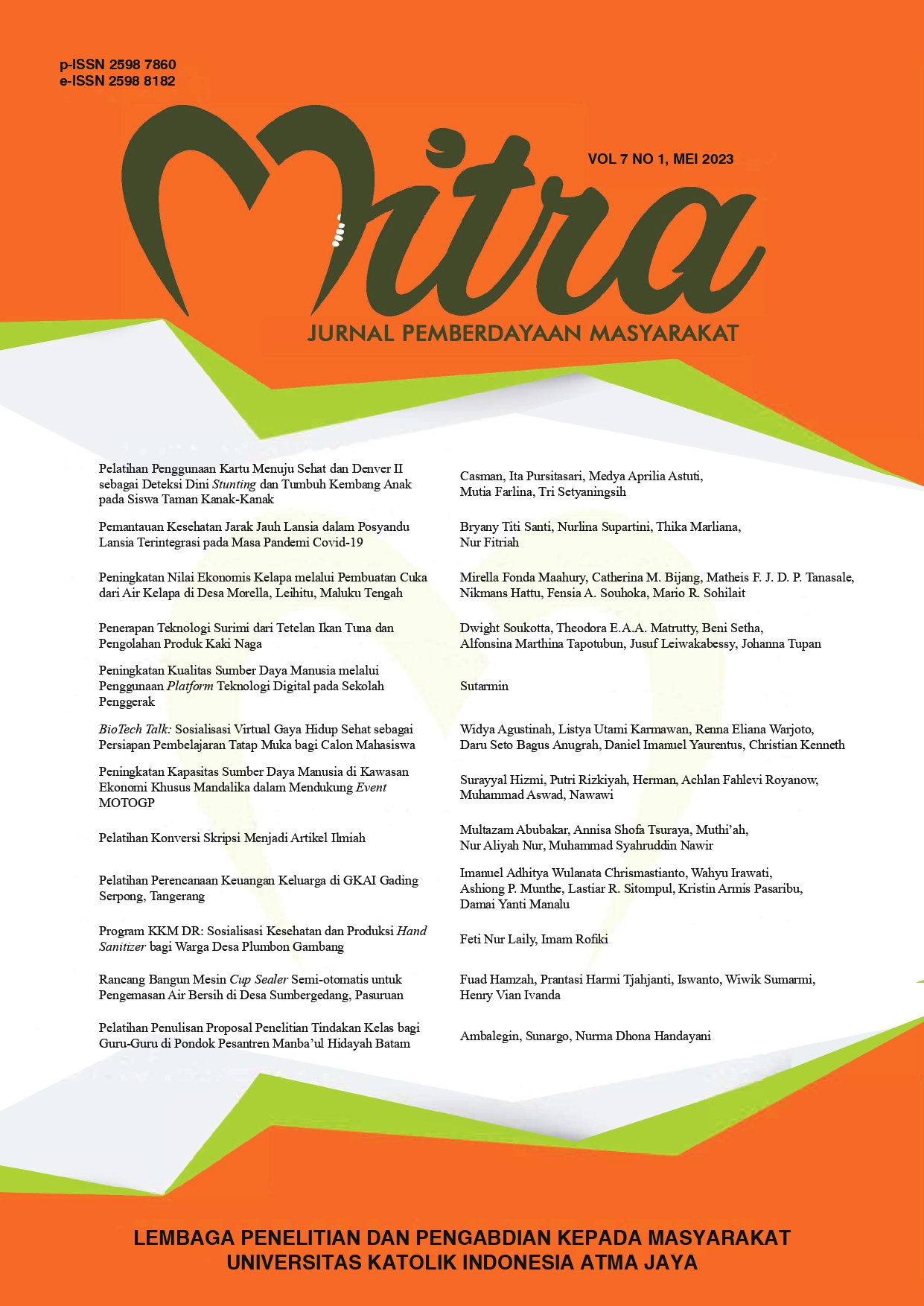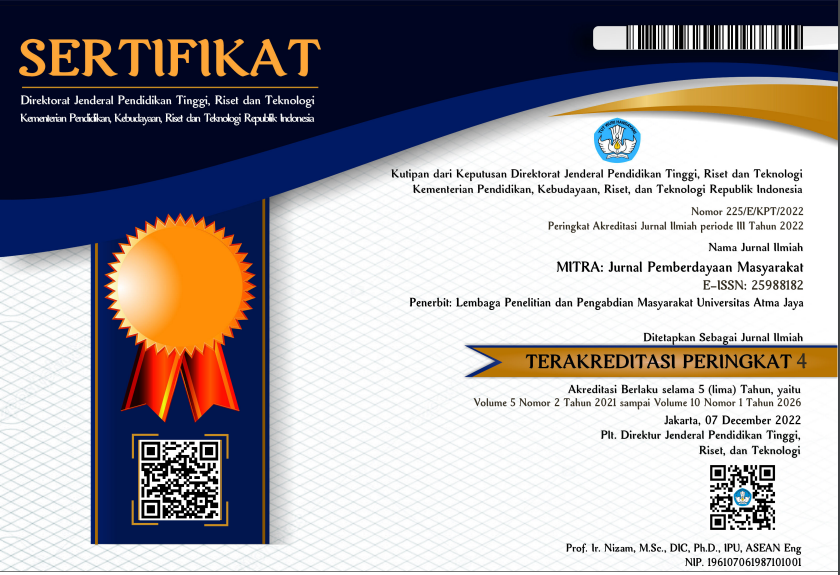Training on The Use of Card to Health and Denver II as Early Detection of Stunting and Child Development on Kindergarten Students
DOI:
https://doi.org/10.25170/mitra.v7i1.3341Keywords:
children; Denver II; Card to Health; stuntingAbstract
Stunting is a worldwide issue that affects children, in which Indonesia has a high stunting rate of 36.4 percent of children stunted. Stunting has a significant negative impact on children's growth and development including nutritional status. To avoid this, it is vital to discover the problem as soon as feasible. The Card to Health (Kartu Menuju Sehat/KMS) and the Denver II instrument can be used for early detection, as well as child growth and development examinations. However, kindergarten teachers, who are on the front lines of education, do not yet have access to KMS and Denver II. The purpose of this activity is to increase teachers' abilities to diagnose stunting in children at a young age using KMS and Denver II. During the months of August to November 2019, the Pelangi Islamic Kindergarten in Depok carried out community service activities. Thirteen teachers and 18 pupils took part in the activity. As a result, 100 percent of teachers improved their ability to use KMS, and up to three children were classified as fat, one had autism, and one had reservations about Denver II. At the Pelangi Islamic Kindergarten, no students are considered stunted. Stunting and nutritional status can be detected by community service activities, and teachers' capacity to detect stunting and nutritional status using KMS and Denver II can be improved significantly.
References
Antarini, & Yanti, E. S. (2021). Penilaian perilaku cuci tangan, penyimpangan perkembangan dan deteksi stunting menggunakan kartu menuju sehat. JKM (Jurnal Kebidanan Malahayati), 7(2), 310–318. https://doi.org/10.33024
Casman, C., Pursitasari, I., Wijaya, A., & Helfiyanti, Y. (2021). Efek stimulasi dini menggunakan baby walker dan balance bike pada perkembangan motorik anak. Jurnal Bahana Kesehatan Masyarakat (Bahana of Journal Public Health), 5(2), 72–77. https://doi.org/10.35910/jbkm.v5i2.526
Dewi, R. C., & Erawati, M. (2014). Pengalaman pengajar PAUD dalam pelaksanaan skrining Denver II pada anak usia pra sekolah. Jurnal Keperawatan Anak, 2(2), 94–100.
Fitriani, S., Dewi, D. N., & Maulana, H. (2021). Edukasi kesehatan tentang gizi pencegahan stunting pada anak sekolah TPA Alhidayah. Jurnal Abdimas Kesehatan Tasikmalaya, 02(03), 32–36.
Hadi, A., Affan, I., & Alfridsyah. (2018). Efektivitas pendidikan gizi menggunakan KMS dinding indeks TB/U terhadap tindakan guru PAUD dalam pemantauan pertumbuhan anak usia 4 – 5 tahun pada anak sekolah PAUD. Jurnal AcTion: Aceh Nutrition Journal, 3(1), 65–73. https://doi.org/10.30867/action.v3i1.
Hadi, A., Afridsyah, & Affan, I. (2019). Efektifitas deteksi stunting menggunakan KMS dinding indeks TB/U pada anak usia 4 – 5 tahun di sekolah PAUD. Jurnal AcTion: Aceh Nutrition Journal, 4(1), 70–74. http://dx.doi.org/10.30867/action.v4i1.160
Kementerian Kesehatan RI. (2018). Buletin jendela data dan informasi kesehatan, situasi balita pendek (stunting) di Indonesia.
Kumalasari. (2020). Hubungan tingkat pengetahuan ibu dalam pemanfaatan kartu menuju sehat (KMS) dengan status gizi balita tahun 2019. CHM-K Applied Scientifics Journal, 3(3), 81–86. https://doi.org/10.37792/casj.v3i3.909
Mualifah, L., & Punjastuti, B. (2019). Pemantauan perkembangan anak dengan DDST. Jurnal Pengabdian Masyarakat Karya Husada, 1(1), 24–29.
Mustofa, F. L., Hutasuhut, A. F., & Larasati, A. (2021). Status gizi anak berhubungan dengan cognitive dan behavioral sesuai denver developmental screening test. JKM (Jurnal Kebidanan Malahayati), 7(2), 347–353. https://doi.org/10.33024
Nurhayu, M. A., Shaluhiyah, Z., Indraswari, R., Masyarakat, F. K., & Diponegoro, U. (2018). Pelaksanaan trias usaha kesehatan sekolah pada tingkat sekolah dasar di wilayah Kecamatan Tembalang Kota Semarang. Jurnal Kesehatan Masyarakat (e-Journal), 6(1), 770–779. https://doi.org/10.14710/jkm.v6i1.20315
Oktiawati, A., Itsna, I. N., Satria, R. P., & Ni’mah, J. (2020). Deteksi dini perkembangan anak dengan DDST (Denver Development Screening Test) di RA / KBIT Siti Khodijah Slawi. JPKMI (Jurnal Pengabdian kepada Masyarakat Indonesia), 1(2), 106–115. https://doi.org/10.36596/jpkmi.v1i2.37
Pantaleon, M. G., Hadi, H., & Gamayanti, L. (2015). Stunting berhubungan dengan perkembangan motorik anak di Kecamatan Sedayu, Bantul, Yogyakarta. Jurnal Gizi dan Dietik Indonesia, 3(1), 10–21. http://dx.doi.org/10.21927/ijnd.2015.3(1).10-21
Pradana, A. A., Casman, C., Rohayati, R., Kamal, M., Sudrajat, A., & Teguh Hidayat, A. (2022a). Program Universal Health Coverage (UHC) di Indonesia. Jurnal Endurance, 7(2), 462–473. https://doi.org/http://doi.org/10.22216/jen.v7i2.1363
Pradana, A. A., Hidayat, A. T., Rohayati, Sudrajat, A., Dewi, N. A., & Casman, C. (2022b). Program Universal Health Coverage (UHC) di Dunia. TIM.
Tampake, R., Arianty, R., Mengundap, S. A., Emy, B., & Sasmita, H. (2021). The effectiveness of training on improving the ability of health cadres in early detection of stunting in toddlers. Open Access Macedonian Journal of Medical Sciences, 9(E), 373–377. https://doi.org/10.3889/oamjms.2021.6067
World Health Organization, (2015). Stunting in a nutshell. https://www.who.int/news/item/19-11-2015-stunting-in-a-nutshell
World Health Organization. (2018). Levels and trends in children malnutrition: UNICEF/WHO/International Bank for Reconstruction and Development, key finding of the 2018 edition.
Downloads
Published
Issue
Section
License
Copyright (c) 2023 Casman Casman, Ita Pursitasari, Medya Aprilia Astuti, Mutia Farlina, Tri Setyaningsih

This work is licensed under a Creative Commons Attribution-NonCommercial-ShareAlike 4.0 International License.
This license allows reusers to distribute, remix, adapt, and build upon the material in any medium or format for noncommercial purposes only, and only so long as attribution is given to the creator. If you remix, adapt, or build upon the material, you must license the modified material under identical terms.



_.jpeg)

.png)
2.png)
.png)
.png)



